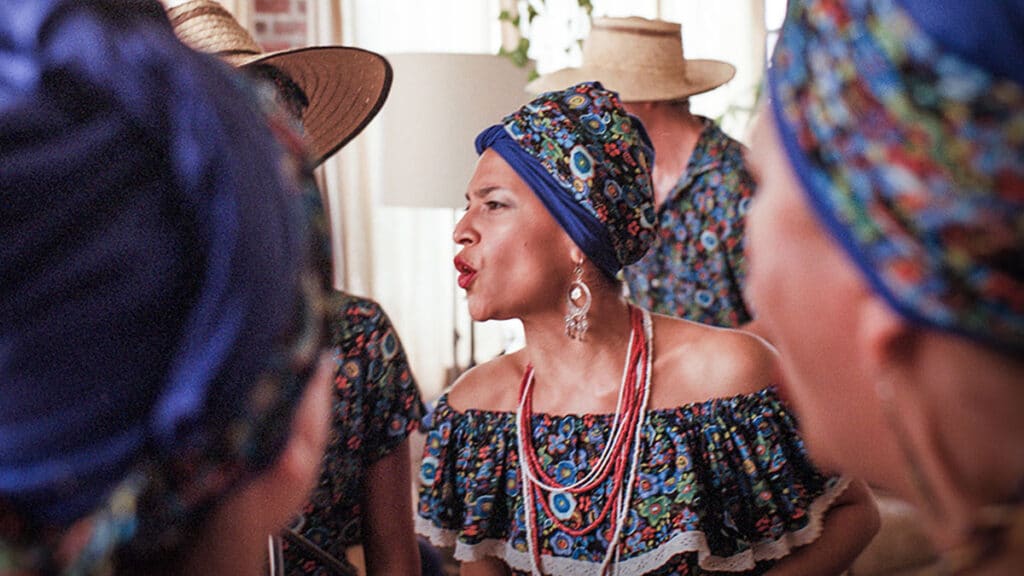Bulla en el Barrio is New York’s first Colombian Bullerengue collective.
Bulla en el Barrio in New York City

Bulla en el Barrio released their debut album, “Vámonos que nos Vamos” on Figure and Ground Records, on November 24, 2023. It’s a record of bullerengue spirituals and traditional songs, written or arranged by Carolina Oliveros and Christian Rodriguez. Buy it on bandcamp.com
Bulla en el Barrio, New York’s Colombian bullerengue group, teaches a workshop and performs at the concert of the New Afro Diasporic Fest 2023 of Afro art, dance, music, and talks at Hostos Center in Mott Haven, The Bronx; on Saturday, October 14, 2023. Workshop at 3pm. Concert at 7pm. FREE. hostos.cuny.edu 🇨🇴 🇨🇺 🇩🇴 🇬🇲 🇭🇳 🇵🇷
Bulla en el Barrio
Bulla en el Barrio was founded by Carolina Oliveros. She was born in the Caribbean city of Barranquilla, Colombia. It’s the port at the mouth of the Magdalena River, Colombia’s great river. Barranquilla is special because the city was built by the people, not the Spanish colonizers.
Bulla en el Barrio is New York’s first bullerengue group. It started in 2014 as a group of women who would sing and dance in Central Park.
Ms. Oliveros learned to sing bullerengue in San Juan de Urabá, on Colombia’s Caribbean coast. Her master teacher was drummer and composer Emilsen Pacheco. He is considered one of the best bullerengue musicians in Colombia.
Venues
These are just some of the venues where the collective has performed.
- Flushing Town Hall
- Hostos Center
- Lincoln Center
- MoMA PS1
- Queens Museum
Bullerengue
Bullerengue was originally sung during women’s puberty celebrations in San Basilio de Palenque, Colombia, the first free African town in the Americas. “Bulla” means applause in Spanish. The tradition was basically community women helping community girls on their transition to the rights and responsibilities of adulthood.
Many Americans have never experienced African Diaspora song, drum, and dance traditions. African Diaspora drums are healing instruments. Get close to them and you may feel it. The singing is call and response, and often includes improvisation just like jazz and rap. Whether you understand the words or not, if you stand among the chorus, you may feel the spiritual presence of everyone singing. It’s a great feeling.
Palenque of San Basilio
A Palenque is a walled village of free Africans and Indigenous Peoples hidden in the interior. San Basilio was the first palenque to win its freedom, but there were many similar enclaves throughout the Americas.
If you have no idea what a palenque is, watch the excellent Colombian telenovela “La Esclava Blanca.” It may be on Netflix with subtitles. The story isn’t perfect, it’s a telenovela. But it provides an interesting window into that time and place.
The people of the Palenque of San Basilio fought back against the Spanish colonizers so ferociously, they were granted freedom in 1691. They were the first free Africans in the Americas.
San Basilio de Palenque is the only Colombian palenque that survives to the present day. It preserves many African traditions. Some people still speak Palenquero, a unique Spanish-Bantu language with roots around West Africa’s Congo River.
The spirit that enabled the people to survive, escape to a palenque, and renew their traditions, lives on. Let freedom sing.
Follow
Follow the group on Instagram @bulla_en_el_barrio
